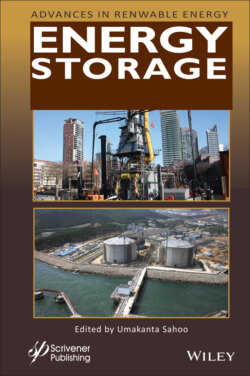Читать книгу Energy Storage - Группа авторов - Страница 30
1.3.4.2 Latent Heat Storage
ОглавлениеLatent heat storage systems including phase change-based systems have attracted more attention in fundamental research as well as in industrial applications. During latent thermal storage, the storage material is heated until it changes phase at constant temperature conditions. Latent heat energy storage allows efficient storage of thermal energy by minimizing the entropy generation in isothermal processes like evaporation or condensation. Latent heat storage systems employ the enthalpy change of a substance passing through a phase change. In CSP technology the development of absorbers directly generating steam have sparked interest in latent heat storage systems.
Latent energy storage systems have high energy density resulting in easily structured, small and flexible designs. The material that is used for latent heat storage systems is called Phase change material (PCM). Latent heat can be absorbed (charging) as well as can be released (discharging) through phase change of the PCM. The amount of latent heat stored in the material (Q) can be calculated as follows:
Here m is the mass of the material and ∆h is the enthalpy of phase change.
Even though there are many advantages of latent heat storage system compared to sensible heat storage system, the major disadvantages of PCM are incongruent phase change, high cost, corrosiveness and less thermal stability. As a result, such materials are still in the research stage and it has not been used by industry for CSP-TES applications. There are many materials that can be used as latent heat storage materials and a list with a few important properties is presented in Table 1.5.
Raul et al. (2018) studied modelling and experimental study of latent heat TES with encapsulated Phase change materials for CSP applications. Soares et al. (2013) reviewed passive PCM latent heat TES systems. Agyenim et al. (2010) reviewed materials, heat transfer and phase change issues for latent heat TES systems. Rathod and Barnerjee (2013) carried out a comprehensive study on thermal stability of PCM used in latent heat TES systems. Further, Cárdenas and León (2013) studied design considerations and performance enhancement procedures for high-temperature latent heat TES systems.
Table 1.5 Typical materials used in latent heat TES systems (Mehling and Cabeza, 2008; Navarro et al., 2012).
| Material | Melting temperature (ºC) | Melting enthalpy (MJ/m3) |
| Water-salt solutions | –100–0 | 200–300 |
| Water | 0 | 330 |
| Clathrates | –50–0 | 200–300 |
| Paraffins | –20–100 | 150–250 |
| Salt hydrates | –20–80 | 200–600 |
| Sugar alcohols | 20–450 | 200–450 |
| Nitrates | 120–300 | 200–700 |
| Hydroxides | 150–400 | 500–700 |
| Chlorides | 350–750 | 550–800 |
| Carbonates | 400–800 | 600–1,000 |
| Fluorides | 700–900 | > 1,000 |
